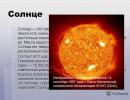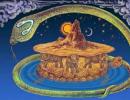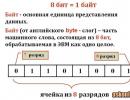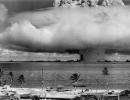The first artificial earth satellite 1957 presentation. Presentation "Artificial Earth Satellites". AES series "Cosmos"
Slide 2
The first artificial satellite of the Earth
Slide 3
Having overcome gravity, the Rocket took off from the Earth... And there was no happier moment - Here a new era began. Stage... second... The third separated, Burning up in the atmosphere without a trace... And a fast-flying star suddenly appeared above the Earth. And Humanity froze in amazement: A silver ball flying in the sky - a great creation of human hands - Was sent from the Earth to the Universe as a gift!
Slide 4
Slide 5
This year, all progressive humanity celebrates the 55th anniversary of the launch of the First artificial Earth satellite. This was the first step towards space exploration.
Slide 6
The purpose of this work is: - Familiarization with the history of the creation of the First artificial Earth satellite (AES); - The significance of the launch of satellites for science and all humanity.
Slide 7
The history of the creation of the first satellite is connected with the work on the rocket itself. Moreover, both in the Soviet Union and in the USA it had a German origin. The main achievements of German specialists were the technology of serial production of powerful liquid-propellant rocket engines and flight control systems.
Slide 8
Single-stage missiles could not satisfy the military - they needed a multi-stage intercontinental missile capable of delivering the “cargo” to any point on the globe. The development of such a rocket was carried out at the Korolev Design Bureau
Slide 9
Sergei Pavlovich Korolev 01/12/1907 - 01/14/1966 Sergei Pavlovich Korolev - chief designer of the first launch vehicles, artificial Earth satellites, manned spacecraft, founder of practical cosmonautics, academician of the USSR Academy of Sciences (1958), Hero of Socialist Labor (1956, 1961), laureate Lenin Prize (1957), member of the CPSU since 1953.
Slide 10
Back in 1939, one of the founders of practical cosmonautics in our country, the closest associate of Sergei Pavlovich Korolev, Mikhail Klavdievich Tikhonravov, wrote: “All work in the field of rocketry, without exception, ultimately leads to space flight.”
Slide 11
Tikhonravov’s group developed the concept of an artificial Earth satellite from 1950 to 1954 almost “underground.” In the foreground (from left to right): Vladimir Galkovsky, Gleb Maksimov, Lidiya Soldatofva, Mikhail Tikhonravov and Igor Yatsunsky; in the background (standing): Grigory Moskalenko, Oleg Gurko and Igor Bazhinov. (Photo from the archive of Asif Siddiqui)
Slide 12
Although the satellite was called the simplest, it was created for the first time; there were no analogues in technology. Only one thing was set - a weight limit (no more than 100 kg). Quite quickly, the designers came to the conclusion that it would be advantageous to make it in the shape of a ball. The spherical shape made it possible to make full use of the internal volume with a smaller shell surface.
Slide 13
Inside the satellite they decided to place two radio transmitters with a radiation frequency of 20.005 and 40.002 MHz. Receiving their signals would allow scientists to study the conditions for the passage of radio waves from space to Earth. In addition, it was necessary to transmit information about the pressure and temperature inside the satellite.
Slide 14
At dawn on October 3, 1957, the rocket, docked with the satellite, was carefully removed from the installation and testing building. Walking nearby were the creators of the world's first space complex. And the bulk of the rocket before the launch was amazingly beautiful. She sparkled all over, covered with frost.
Slide 15
On October 4, 1957, at 22:28 Moscow time, a bright burst of light illuminated the night steppe, and the rocket went up with a roar. Her torch gradually weakened and soon became indistinguishable against the background of the heavenly bodies.
Slide 16
“He was small, this very first artificial satellite of our old planet, but his sonorous call signs spread across all continents and among all peoples as the embodiment of the daring dream of mankind.” S. Korolev
Slide 17
In an hour and a half - a trip around the world, 15 revolutions per day, and each time along a new route, because the plane of the satellite’s orbit in space is stationary, and the Earth rotates around its axis inside this orbit. Thousands of eyes and radios watched his flight. And every hour of his life interested scientists.
Slide 18
For the first time in history, hundreds of millions of people could observe in the rays of the rising or setting sun an artificial star, created not by gods, but by the hands of man, moving across the dark sky. And the world community perceived this event as the greatest scientific achievement. For the first time, the first cosmic velocity was achieved, calculated by the founder of classical physics and the law of universal gravitation, the Englishman Isaac Newton (1643 - 1727).
Slide 19
On February 1, 1958, the first American satellite, Explorer-1, was launched into orbit, and a little later, other countries also launched independent satellites: November 26, 1965 - France (satellite A-1), November 29, 1967 - Australia (VRSAT-1). 1"), February 11, 1970 - Japan ("Osumi"), April 24, 1970 - China ("China-1"), October 28, 1971 - Great Britain ("Prospero").
Slide 20
Thanks to these flights, people began to realize that humanity has one single home, one planet, and there is a goal that can unite all peoples - the study of the Earth for the benefit of all people. Outer space became an arena for scientific cooperation, and world science was enriched with new invaluable data.
Slide 21
The pioneers of practical astronautics, the creators of the first artificial Earth satellites, knew how to look far ahead. But even in those years they would hardly have been able to imagine that their small and, from a modern perspective, simple devices would give rise to the formation of a grandiose system.
Slide 22
The flight of the first satellite became the beginning of a whole series of courageous deeds of all mankind, who saw satellites in space, the first flight of man into space, the first steps on the Moon, the first radio transmissions from Mars and from space probes that visited the planets of the Solar System.
Slide 23
Over the past 55 years, more than one thousand spacecraft have been launched into near-Earth orbits. Their orbits encircle the Earth in a dense grid; they “see” everything that happens on Earth. Together they constitute a gigantic information system.
Slide 24
We can conclude that science needs astronautics - it is a grandiose and powerful tool for studying the Universe, the Earth, and man himself. Cosmonautics is vital for all humanity! Every year, satellite systems will become an increasingly significant part of the Unified Communications System.
Slide 25
This work was presented in grades 7-9 at the school on Cosmonautics Day and dedicated to the 55th anniversary of the launch of the first artificial Earth satellite.
Slide 26
List of sources used 1. V.P. Glushko “Cosmonautics”. Publishing house “Soviet Encyclopedia” 1970 2. “Rocket and Space Corporation “Energia” named after S.P. Korolev", Publishing House RSC "Energia", 1996. 3. Talyzin N.V. "Communications satellites - Earth and Universe." 4. images.yandex.ru 5. microchooser.com 6. ru.wikipedia.org
View all slides
1 slide

2 slide
Launch of the first artificial Earth satellite On October 4, 1957, the whole world was shocked by the news that the first Soviet artificial Earth satellite, Sputnik-1, had been launched into low-Earth orbit. This is how the first step into heaven was taken. “It was small, this very first artificial satellite of our old planet, but its ringing call signs spread across all continents and among all peoples as the embodiment of the daring dream of mankind,” said the chief designer of rocket and space systems, S.P. Korolev.

3 slide

4 slide
Man has dreamed of flying for a long time. And he not only dreamed, but also built his own hypotheses about this. For example, back in 1687, the great mathematician and physicist Newton suggested that if a lead ball was fired from a cannon standing on a mountain, it would fly several miles along a curve before falling to the ground. If you shoot it with double force, it will fly even further. By increasing the speed, you can increase the flight range, or you can make it surround the entire earth and even go into the celestial spaces. K. E. Tsiolkovsky was the first to translate dreams into reality when he derived a formula for determining the speed of a rocket in outer space. Thus, already at the beginning of the 20th century. the theoretical possibility of manufacturing artificial Earth satellites appeared. The impetus for their creation was the successful development of the first ballistic missile. A group of scientists led by Academician M.V. Keldysh dealt with the problems of its design and testing. For the first time, the decision to create an unoriented Earth satellite launched using an intercontinental ballistic missile was made in 1956. According to preliminary calculations, it was supposed to weigh approximately 1000-1400 kg, of which 200-300 kg was allocated for scientific equipment. The first launch was scheduled for 1957. At this time, the United States was preparing to launch its artificial satellite. But the first attempt was unsuccessful, and the US Navy Avangard rocket capsized on the launch pad and exploded.

5 slide
Scientists decided to make the Soviet satellite in the shape of a ball, which would make it possible to make full use of its internal volume. When finished, Sputnik 1 (as it received its name) weighed only 83.6 kg; its diameter was 58 cm. To better reflect sunlight and ensure the necessary thermal conditions, the body was made of aluminum alloy. The device was powered by silver-zinc batteries capable of operating for 2-3 weeks. Four rod-shaped antennas 2.9 m long were installed on the outer surface of the device, occupying a working position after entering orbit. Such a four-antenna system reduced the influence of Sputnik 1’s rotation on the quality of signals received on Earth. In the internal space of the sphere filled with nitrogen, a constant temperature was maintained using ventilation, regulated using signals from special temperature sensors. Inside the device were two radio transmitters, transmitting information about the pressure and temperature inside the satellite. Using the data obtained, scientists studied the conditions for the passage of radio waves from space to Earth. The signals were transmitted in the same way as by telegraph, with a wave duration of 0.3 seconds. The transmitters worked alternately, changing after continuous operation for 14 seconds. The first satellite was called the simplest, although it had no analogues in the technology of that time. With its help, it was possible to conduct a number of scientific studies. For example, thanks to the spherical shape of the Sputnik-1 body, it was possible to determine the density of the atmosphere at high altitudes with the greatest accuracy.

6 slide
October 4, 1957 at 10:28 p.m. Moscow time, Sputnik 1 was launched into orbit. It began sending its first signals from space immediately after separating from the last stage of the rocket. The first spacecraft made 1440 revolutions around the Earth, spending 96 minutes on each revolution. 10.2 sec. Its maximum distance from the Earth's surface was 947 km. It was in low-Earth orbit for only 92 days, after which it burned up in the dense layers of the atmosphere. But this day became the beginning of a new, space era for humanity, and the Russian word “sputnik” entered many languages of the world.
Launch of the first artificial Earth satellite On October 4, 1957, the whole world was shocked by the news that the first Soviet artificial Earth satellite, Sputnik-1, had been launched into low-Earth orbit. This is how the first step into heaven was taken. “It was small, this very first artificial satellite of our old planet, but its sonorous call signs spread across all continents and among all peoples as the embodiment of the daring dream of mankind,” said the chief designer of rocket and space systems S.P. Korolev.


Man has dreamed of flying for a long time. And he not only dreamed, but also built his own hypotheses about this. For example, back in 1687, the great mathematician and physicist Newton suggested that if a lead ball was fired from a cannon standing on a mountain, it would fly several miles along a curve before falling to the ground. If you shoot it with double force, it will fly even further. By increasing the speed, you can increase the flight range, or you can make it surround the entire earth and even go into the celestial spaces. K. E. Tsiolkovsky was the first to translate dreams into reality when he derived a formula for determining the speed of a rocket in outer space. Thus, already at the beginning of the 20th century. the theoretical possibility of manufacturing artificial Earth satellites appeared. The impetus for their creation was the successful development of the first ballistic missile. A group of scientists led by Academician M.V. Keldysh dealt with the problems of its design and testing. For the first time, the decision to create an unoriented Earth satellite launched using an intercontinental ballistic missile was made in 1956. According to preliminary calculations, it should have weighed about kg, of which kg was allocated for scientific equipment. The first launch was scheduled for 1957. At this time, the United States was preparing to launch its artificial satellite. But the first attempt was unsuccessful, and the US Navy Avangard rocket capsized on the launch pad and exploded.

Scientists decided to make the Soviet satellite in the shape of a ball, which would make it possible to make full use of its internal volume. When finished, Sputnik 1 (as it received its name) weighed only 83.6 kg; its diameter was 58 cm. To better reflect sunlight and ensure the necessary thermal conditions, the body was made of aluminum alloy. The device was powered by silver-zinc batteries capable of operating for 2–3 weeks. Four rod-shaped antennas 2.9 m long were installed on the outer surface of the device, occupying a working position after entering orbit. Such a four-antenna system reduced the influence of Sputnik 1’s rotation on the quality of signals received on Earth. In the internal space of the sphere filled with nitrogen, a constant temperature was maintained using ventilation, regulated using signals from special temperature sensors. Inside the device were two radio transmitters, transmitting information about the pressure and temperature inside the satellite. Using the data obtained, scientists studied the conditions for the passage of radio waves from space to Earth. The signals were transmitted in the same way as by telegraph, with a wave duration of 0.3 seconds. The transmitters worked alternately, changing after continuous operation for 14 seconds. The first satellite was called the simplest, although it had no analogues in the technology of that time. With its help, it was possible to conduct a number of scientific studies. For example, thanks to the spherical shape of the Sputnik-1 body, it was possible to determine the density of the atmosphere at high altitudes with the greatest accuracy.

October 4, 1957 at 10:28 p.m. Moscow time, Sputnik 1 was launched into orbit. It began sending its first signals from space immediately after separating from the last stage of the rocket. The first spacecraft made 1440 revolutions around the Earth, spending 96 minutes on each revolution. 10.2 sec. Its maximum distance from the Earth's surface was 947 km. It was in low-Earth orbit for only 92 days, after which it burned up in the dense layers of the atmosphere. But this day became the beginning of a new, space era for humanity, and the Russian word “sputnik” entered many languages of the world.



Nikolai Zinoviev The Shore of the Universe We are destined to draw heavenly maps. Three minutes before the start... This moment will not be forgotten. Somewhere in the starry abyss the Unfamiliar is waiting, the Infinite in blue beckons and calls us. We will certainly be There, by the Sea of Dreams, Talking to the Universe, Like with a friend, on a first name basis. After all, Copernicus never dreamed that his descendants would make the Earth the shore of the Universe. 1961, April 13

Bibliography. Wreath to Gagarin: Sat. poem. – M.: Soviet Russia, – 108 p. World Encyclopedia of Astronautics/A-K. – M.: Military parade, – 502 p. Cosmonautics: Small Encyclopedia.- M.: Soviet Encyclopedia p. Cosmonautics at the turn of the millennium: Results and prospects. - 2nd ed., revised. and additional - M.: Mechanical Engineering, p. Cosmonautics: Encyclopedia. – M.: Soviet Encyclopedia, – 526 p. Eliasberg P.E. Introduction to the theory of flight of artificial Earth satellites. - M.: Nauka, – 540 p.


Start. The United States was able to repeat the success of the USSR only on February 1, 1958, launching on the second attempt the Explorer 1 satellite, weighing 10 times less than the first satellite. The launch was carried out from the 5th research site of the USSR Ministry of Defense "Tyura-Tam" (which later received the open name of the Baikonur Cosmodrome). The PS-1 satellite flew for 92 days, until January 4, 1958, completing 1,440 revolutions around the Earth (about 60 million kilometers), and its radio transmitters operated for two weeks after


Sergei Pavlovich Korolev is a Soviet scientist, designer and organizer of the production of rocket and space technology and rocket weapons of the USSR, the founder of practical cosmonautics. The largest figure of the 20th century in the field of space rocketry and shipbuilding.

An advanced rocket and space power, and a key figure in human space exploration, the creator of practical astronautics. Thanks to his ideas, the first artificial Earth satellite and the first cosmonaut, Yuri Gagarin, were launched. S.P. Korolev is the creator of Soviet rocket and space technology, which ensured strategic primacy and made the USSR

Quiz dedicated to the 55th anniversary of the launch of the first artificial Earth satellite. 1.What event marked the beginning of the space age in human history? 2.Where and when did this event happen? 3. In what star system is our Galaxy located? 4.How many planets of the solar system can be seen with the naked eye? List their names. 5.Which planet is called red and why? 6.On which planet of the solar system were dried up river beds discovered? 7.What are stars? 8.Why do stars have different colors? 9.Which planet of the solar system is the brightest in the night sky? 10.Which of the planets in the solar system is the smallest? 11.Which of the planets in the solar system is the largest? 12. In which month of the year are the Earth closest to the Sun? 13.The first woman is an astronaut.

14.Who and when was the first to perform a spacewalk, moved away from the spacecraft by about 5 meters and stayed in outer space for 12 minutes. 9 pp.? 15.Soviet designer of rocket and spacecraft, it was under his leadership that the first manned flight was prepared in the USSR. 16.Name the names of dogs that have been in space and returned safely to Earth. 17.Yuri Gagarin maintained continuous radio contact with the Mission Control Center. What was the astronaut's call sign? 18. How long did Yuri Gagarin’s flight in space last? 19.Which earthling was the first to visit the Moon? 20.What was the name of the spaceship on which Yuri Gagarin made his flight? 21.The name of the cosmodrome from which the first artificial Earth satellite in history was launched and the first cosmonaut in history flew.

October 4, 2017 marks the 60th anniversary of the beginning of the space age of mankind. On October 4, 1957, the first artificial Earth satellite was launched from the Baikonur Cosmodrome on a Sputnik launch vehicle.
During the class hour, students will expand their knowledge about the scientific activities of Sergei Pavlovich Korolev, the founder of practical cosmonautics in our country, get acquainted with the characteristics of the first satellite, and also learn what types of satellites exist today and what tasks they perform.
Lesson option [PDF ] [DOCX ]
Presentation [PDF] [PPTX]
Rules for the quiz [PDF] [DOCX]
Target:
- systematize and expand students’ understanding of the launch of the first artificial Earth satellite.
Tasks:
- expand students’ understanding of space exploration;
- introduce the artificial satellites of the Earth and their role in the life of modern man;
- to form a sense of patriotism through studying the great achievements of the Russian people;
- fostering a sense of cooperation.
The theme of our class hour is “60 years since the launch of the first artificial Earth satellite.”
And I would like to start it with the words of the founder of practical cosmonautics in our country, Sergei Pavlovich Korolev:
“The time will come when a spaceship with people will leave the Earth and go on a journey. A reliable bridge from earth to space has already been built by the launch of Soviet artificial satellites, and the road to the stars is open!”
The space age in human history began on October 4, 1957, when the first artificial Earth satellite was launched into orbit. The code designation of the satellite is PS-1 (Simple Sputnik – 1).
It was launched from the Baikonur Cosmodrome on a Sputnik launch vehicle, created on the basis of the R-7 intercontinental ballistic missile.
Let's see video clip “Satellite launch”.
The flight of the first artificial Earth satellite was seen by the whole world.
The signal sent by the satellite was caught by any radio amateur anywhere in the world.
Many scientists worked on the creation of an artificial Earth satellite.
This work was headed by Sergei Pavlovich Korolev, a Soviet scientist, design engineer, and founder of practical cosmonautics.
Under the leadership of Sergei Pavlovich Korolev, the launch of the planet's first cosmonaut was carried out. Let's see video about the scientific activities of Sergei Pavlovich Korolev.
Watching and discussing a video about the scientific activities of Sergei Pavlovich Korolev.
During the launch of the first artificial Earth satellite, the following tasks were set:
- check the correctness of the calculations and technical solutions on which the launch was based;
- determine the density data of the upper layers of the atmosphere from the descent braking of the spacecraft;
- investigate the ionospheric propagation of radio waves emitted by satellite transmitters;
- analyze the conditions for adequate operation of the equipment of other aircraft.
Externally, the satellite was an aluminum sphere with a diameter of 58 cm, to which two curved antennas were attached crosswise, allowing the device to distribute radio emission evenly and in all directions.
Inside the sphere, made of two hemispheres fastened with 36 bolts, there were 50-kilogram silver-zinc batteries, a radio transmitter, a fan, a thermostat, pressure and temperature sensors. The total weight of the device was 83.6 kg.
PS-1 was in orbit for 92 days and during this time completed 1,440 revolutions around the Earth, thus covering about 60 million kilometers. The satellite's radio transmitters operated for two weeks after launch. Then the device burned up in the upper layers of the Earth's atmosphere.
The news about the satellite launched into low-Earth orbit by Soviet scientists instantly spread throughout the world. The launch of the first Earth satellite made it possible to obtain not only important technical data necessary for the further development of astronautics, but also valuable scientific information.
Newspapers published articles dedicated to the first artificial satellite of the Earth.
Postage stamps were issued to commemorate the launch of Sputnik.
Monuments were erected to commemorate the launch of satellites
Modern artificial Earth satellites perform many tasks and, depending on them, are divided into several types:
– astronomical satellites are used to study space objects and phenomena; in essence, these are mobile observatories outside the Earth;
– reconnaissance vehicles supply information to the military departments of their countries about the location and movement of strategic objects in the studied territory;
– communication satellites are needed to transmit radio signals between very distant points on the surface that are beyond the line of sight;
– navigation satellites ensure the operation of the GPS global positioning system, which is very important for determining the location of vehicles;
– meteorological satellites are indispensable for studying the weather and making weather forecasts;
– remote sensing satellites, using radar and photography of the Earth’s surface, carry out exploration of mineral deposits, accounting for the location of natural resources, and monitoring the state of the ecological system;
– research of living organisms in space conditions is carried out on biosatellites;
– Experimental satellites are launched to test new developments.
Now the number of artificial objects in earth's orbit exceeds 15.5 thousand.
Conducting a quiz.
The quiz is conducted according to the principle of the TV game “Own Game”.
As a conclusion to the class hour, it is proposed
Rules for the quiz
To conduct the quiz, the class is divided into two teams. A draw is held to determine which team starts the game. Team representatives select questions. If the question is answered correctly, the team continues the game. If the answer is incorrect, the other team enters the game. The winner is the team with the most points.
Sources:
- History of the development of domestic automatic spacecraft // Scientific editor I. V. Barmin. – M.: Capital Encyclopedia, 2015. – 752 p.






